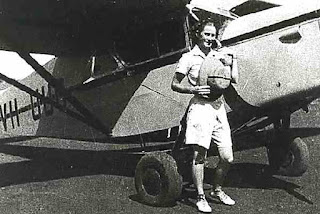A plane landed on a grazier's property to rescue the owner from a flood. Onlookers were aghast to see that the pilot was a woman. This was the 1930s and female pilots were only accepted in the United States. Nancy Bird Walton was the pilot - she had the right name.
The woman who would not take no for an answer had initially taken flying lessons from the famous aviator Sir Charles Kingsford Smith. Because she was short he told her to bring a cushion. Her pilots' test involved a climbing to 450 meters then landing near a fixed spot on the ground. She passed gaining an A grade licence. her career began in 1928 flying a yellow Gypsy Moth at an air pageant in New South Wales.
In those days a commercial pilot had to be a mechanic as well. She was capable. Securing a log book, knowledge of meteorology and navigation skills she was on her way. The Gypsy Moth was ideal for Barnstorming around the country. She saved some money. Her purchase of Leopard Moth set her up in commercial business carrying freight and passengers.
During her working life she flew to remote areas for the Royal Flying Doctor Service becoming the first female owner pilot of the Far West Children's Health Scheme. Notably, she became the Commandant of the Women's Air Training Corp when WWII broke out.
The woman who would not take no for an answer had initially taken flying lessons from the famous aviator Sir Charles Kingsford Smith. Because she was short he told her to bring a cushion. Her pilots' test involved a climbing to 450 meters then landing near a fixed spot on the ground. She passed gaining an A grade licence. her career began in 1928 flying a yellow Gypsy Moth at an air pageant in New South Wales.
In those days a commercial pilot had to be a mechanic as well. She was capable. Securing a log book, knowledge of meteorology and navigation skills she was on her way. The Gypsy Moth was ideal for Barnstorming around the country. She saved some money. Her purchase of Leopard Moth set her up in commercial business carrying freight and passengers.
During her working life she flew to remote areas for the Royal Flying Doctor Service becoming the first female owner pilot of the Far West Children's Health Scheme. Notably, she became the Commandant of the Women's Air Training Corp when WWII broke out.
